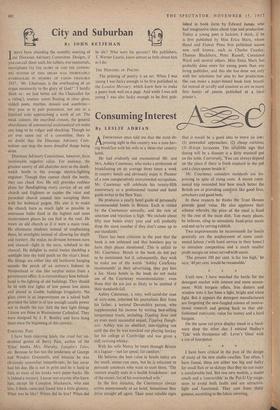City and Suburban
By JOHN BETJEMAN IT HAVE been attending the monthly meeting of Diocesan ,Advisory Committee. Designs, if you can call them such, for tablets,war memorials, inscriptions (TO THE GLORY OF GOD THE SYPHON- ING SYSTEM OF THIS ORGAN WAS THOROUGHLY OVERHAULED IN MEMORY OF CANON CHASUBLE 1957 'Mr. Chairman, is the overhauling of an organ necessarily to the glory of God?' 1 hardly think so : we had better ask the Chancellor for a ruling"), antemic saints floating in clear glass, riddell posts, retables, dossals and aumbries- they pass us in pale procession, not one in a hundred even approaching a work of art. The weak colours, the inscribed crosses, the general churchiness of commercial ecclesiastical art make one long to be vulgar and shocking. Though no art ever came out of a committee, there is no doubt that the Diocesan Advisory Com- mittees can stop the more dreadful things being done.
Diocesan Advisory Committees, however, have inestimable negative value. For instance, the greatest enemy of old churches next to the death- watch beetle is the average electric-lighting engineer. Though they cannot check the beetle, they can check him. He still provides ruthless plans for floodlighting every crevice of an old church and frightens or cajoles the vicar and parochial church council into accepting them with his technical jargon. His aim is to make the church burn as much light as possible in enormous bulbs fixed in the highest and most inconvenient places he can find in the roof. He treats an old church as if it were a main road. He eliminates shadows instead of emphasising them, he overlights instead of allowing for depth and mystery. He makes no division between nave and chancel—light in the nave, subdued in the chancel. He delights in metal basins shedding a spotlight into the bald patch on the vicar's head. His fittings are either like old lanthorns hanging outside the porch of an actress's hideout in Maidenhead or else like surplus stores from a government office. It is extraordinary how behind- hand is the lighting of old buildings. They should be lit with few lights of low power low down and placed in Gothic buildings irregularly. No glass cover is an improvement on a naked bulb provided the latter is of low enough candle power not to dazzle the eye. Still the best light fittings I know are those in Westminster Cathedral. They were designed by J. F. Bentley and have hung there since the beginning of this century.
ENJOYING PAIN
1 have been enjoying lately the cruel but un- doubted genius of Barry Pain, author of the 'Eliza' books, Mrs. Murphy, Twnplin's Tales, etc. Because he has not the tenderness of George and Weedon Grossrnith, and because he was obviously somewhat misanthropic, he has never had his due. He is not in print and he is hard to find, as most of his books were paper-backs. He is indeed a mystery. I never met anyone who knew him, except Sir Compton Mackenzie, who met him, I think, once and found him a little gloomy. What was he like? Where did he live? When did he die? Who were his parents? His publishers, T. Werner Laurie, know almost as little about him as I do.
THE PRINTING OF POETRY The printing of 'poetry is an art. When 1 was young I was lucky enough to be first published in the London Mercury, which knew how to make a poem look well on a page. And while hwas still young I was also lucky enough to be first pub- lished in book form by Edward James, who had imaginative ideas about type and production. Today a young poet is luckiest, I think, if he is first published by Miss Erica Marx, whose Hand and Flower Press first published names now well known, such as Charles Causley, Thomas Blackburn, Peter Russell, Constance Ward and several others. Miss Erica Marx has probably done more for young poets than any living publisher, and this she has done not only with her selections but also by her production. She can make a paper-bound book look beauti- ful instead of scruffy and amateur as are so many first books of , poems published at a local printer's.


































 Previous page
Previous page